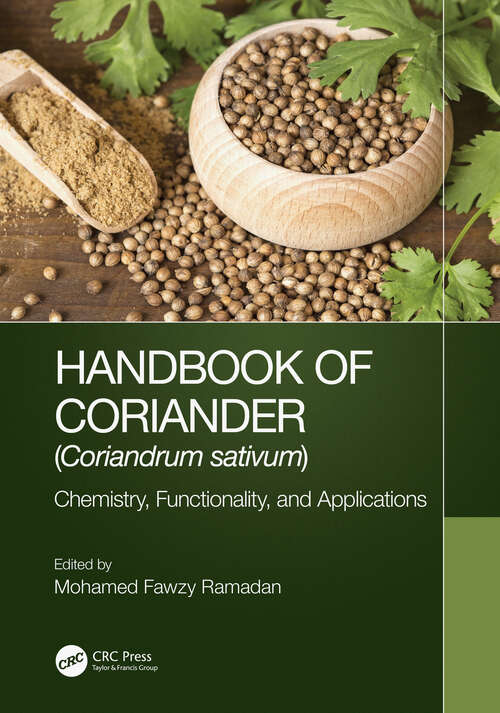Handbook of Coriander (Coriandrum sativum): Chemistry, Functionality, and Applications
By:
Sign Up Now!
Already a Member? Log In
You must be logged into Bookshare to access this title.
Learn about membership options,
or view our freely available titles.
- Synopsis
- Coriander (Coriandrum sativum L., family Umbelliferae/Apiaceae) is one of the most popular spices globally. Different parts of Coriandrum sativum are edible and widely used as a seasoning due to their unique flavor and aroma. Coriandrum sativum medical uses have been recognized since ancient times. Coriander leaves (cilantro) and coriander fruit (seed) are used in different ethnic foodstuffs, meat and poultry dishes, soup, pudding, bread, and seafood dishes. Coriandrum sativum is rich in linalool, vitamin A, vitamin B12, vitamin C, folate, and phenolics. Coriandrum sativum fixed oil is rich in sterols, tocols, and bioactive phytochemicals. Petroselinic acid is the major fatty acid in Coriandrum sativum fixed oil and exhibits health-promoting traits. Coriandrum sativum is recommended as a food preservative to replace synthetic antioxidants because of its antioxidant and antibacterial traits. Furthermore, Coriandrum sativum cilantro and seeds are rich in water-soluble and lipid-soluble phytochemicals that showed unique anticancer, anxiolytic, neuroprotective, migraine-relieving, hypoglycemic, hypolipidemic, anticonvulsant, analgesic, and anti-inflammatory traits. Those medical benefits and their integration into daily life render Coriandrum sativum an excellent functional food. Regarding the cosmetic industry, Coriandrum sativum is used as an ingredient in conventional Ayurvedic cosmetic formulations to normalize skin color. In addition, Coriandrum sativum volatile oil finds use as an ingredient in perfumes. Handbook of Coriander (Coriandrum sativum): Chemistry, Functionality, and Applications is a valuable resource for pharmaceutical and nutraceutical developers, as well as novel food developers and R&D researchers in a variety of fields that use herbs, spices, and medicinal plants. Key Features: Explores the chemistry of Coriandrum sativum phytochemicals, oils, and extracts Discusses Coriandrum sativum active constituents and their health-enhancing traits Presents the applications of Coriandrum sativum phytochemicals, oils, and extracts Addresses the growing application areas, including horticulture, functional food, clinical nutrition, pharmaceuticals, and cosmetics Authored by international scientists and industry experts, this book is a great resource for food chemistry, clinical nutrition, biochemistry, pharmacology, and horticulture researchers and students, as well as developers of novel food, cosmetics, and pharmaceuticals, in addition to R&D researchers in different sectors that utilize herbs, spices, and medical plants.
- Copyright:
- 2023
Book Details
- Book Quality:
- Publisher Quality
- Book Size:
- 568 Pages
- ISBN-13:
- 9781000820379
- Related ISBNs:
- 9781032068527, 9781003204626, 9781032069333
- Publisher:
- CRC Press
- Date of Addition:
- 02/10/23
- Copyrighted By:
- Mohamed Fawzy Ramadan
- Adult content:
- No
- Language:
- English
- Has Image Descriptions:
- No
- Categories:
- Nonfiction, Technology
- Submitted By:
- Bookshare Staff
- Usage Restrictions:
- This is a copyrighted book.
- Edited by:
- Mohamed Fawzy Ramadan
